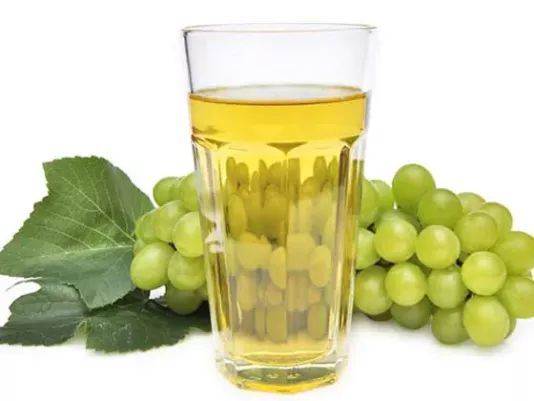Bilberries Sauce
Bilberries Sauce – French cuisine recipe with bilberries, balsamic vinegar and honey.

Grape Juice is something I began making in my youth, when I first encountered an abundant grape harvest and realized that this product could be used much more widely than just for fresh eating. Over the years, I have learned to see it not only as a drink but also as a versatile ingredient that adds depth and richness to dishes. In my practice, it became the foundation for marinades, gravies, and even cake batter, where the natural sugars of the grapes form a pleasant caramel shade after baking. I always pay attention to the ripeness of the berries: overripe ones give excessive sweetness, while underripe ones leave too sharp an acidity. An important discovery was that the processing method – from manual pressing to using a steamer juicer – significantly affects the flavor and clarity of the drink. For me, grape juice is always a combination of attentiveness, experience, and an understanding of subtle nuances, because perfection is born in the details.
Over years of cooking, I have learned how to determine which grapes are best for making juice. To achieve a rich and balanced flavor, I always prefer ripe berries without cracks or damage. White varieties produce a light, delicate drink with gentle sweetness, while dark varieties create a denser taste and more pronounced aroma. I noticed that blending different varieties allows for a deeper flavor profile than using just one type. I always pay attention to the cleanliness of the berries: the bloom should be natural and light, not overly dense, which may indicate excessive moisture or improper storage. Another key factor is the balance between sugar and acidity: overly sweet grapes make the juice cloying, while sour ones make it too sharp. In my experience, the best time for harvest is late summer or early fall, when grapes reach optimal ripeness. I always avoid fruits with broken stems or spots, as these lower the quality of the juice. Choosing the right grapes is the first step toward juice that is tasty, balanced, and healthy.
In my practice, I found that the quality of preparation directly determines the purity of the juice’s flavor. I always carefully separate the grapes from the clusters, avoiding green stems, as they give bitterness. Next comes rinsing in cool water: this step is essential, since even light dust or soil residue can alter the taste. When working with large quantities, I always spread the grapes in a thin layer to inspect each one and remove the damaged ones. Over the years, I realized that pre-chilling the grapes makes pressing easier and helps preserve the freshness of the aroma. In some cases, I use light blanching, especially for dark varieties: it helps separate the pulp and skin, making the juice richer. If I plan to prepare juice for long-term storage, I always include pasteurization, but only after thorough preparation to avoid unpleasant flavors. For me, these steps have become a habit that guarantees consistently high results.
Over the years, I have tested various methods of extracting grape juice and realized that each has its advantages and risks. Manual pressing preserves maximum aroma but requires time and effort, while a steamer juicer gives a higher yield but loses some aroma due to high temperatures. In my practice, I often combine methods: first crushing the grapes, then carefully heating the mass to 70°C (158°F) to preserve color and aroma. If the temperature rises higher, the taste becomes cooked and less expressive. To achieve clear juice, I use cheesecloth or a fine sieve to separate the pulp, though sometimes I leave a small amount if I want a thicker consistency. It is very important to avoid contact with metal utensils, which can alter the flavor profile. I have learned that just a few minutes or degrees can determine the quality of the final product. That is why I always monitor the process carefully, to obtain a stable, aromatic, and healthy drink.
In my practice, grape juice has become a versatile base for creating a variety of dishes. I often use it for marinades: its natural acidity tenderizes meat, making it softer. In desserts, it pairs wonderfully with apples, pears, and citrus fruits, creating a rich fruit profile. For sauces, I combine the juice with spices – cinnamon, cloves, nutmeg – as they emphasize its aroma and add depth. Baked goods made with grape juice develop gentle sweetness without excess sugar, and their color becomes more appealing. I noticed that adding a small amount of juice to gravies for poultry or beef creates an interesting contrast and a harmonious flavor. It is important to remember that grape juice has a strong character of its own, so it should be paired with ingredients that complement it, not overpower it. This is how I create dishes where the juice is an accent but does not take the lead role.
Over years of cooking, I have often seen inexperienced cooks make mistakes when working with grape juice. The most common one is using overripe grapes: such juice turns out too sweet and spoils quickly. Another problem is neglecting the sterility of containers during preservation: this can cause spoilage even after pasteurization. In my practice, I always check the cleanliness and tightness of containers, as this ensures safety and long storage. I have also seen how excessive boiling causes the juice to lose its aroma and resemble ordinary compote. To avoid this, I control the temperature and never allow prolonged intense boiling. Another mistake is adding too much sugar, which destroys the natural balance. I always recommend adding sweetener gradually, tasting as you go. For me, quality control means attention to detail: from selecting grapes to storage methods. Only this way can you obtain a drink that is at once tasty, healthy, and safe for the family.